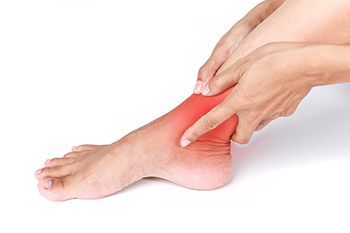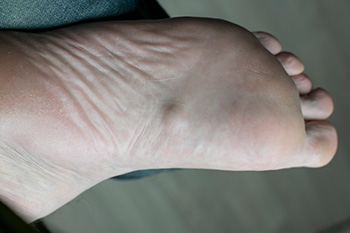
Ankle bursitis occurs when the bursae, small fluid-filled sacs that cushion the bones, tendons, and muscles in the ankle, become inflamed. Ankle bursitis can cause pain, swelling, tenderness, and difficulty in moving the ankle. Irritation or injury to these sacs is often caused by repetitive motion, direct trauma, or wearing improper footwear, resulting in discomfort and stiffness. Certain medical conditions, such as gout or rheumatoid arthritis, may also increase the likelihood of developing ankle bursitis. Symptoms include tenderness, warmth, and visible swelling in the ankle, which may worsen with movement or pressure. A podiatrist can diagnose ankle bursitis by assessing symptoms, conducting a physical examination, and using imaging tests to rule out other conditions. Treatment options include reducing strain on the ankle with supportive footwear or orthotics, medication to alleviate inflammation, and, in severe cases, surgery to remove the inflamed bursa. If you are experiencing ankle pain, it is suggested that you schedule an appointment with a podiatrist for a diagnosis and appropriate treatment options.
Ankle pain can have many different causes and the pain may potentially be serious. If you have ankle pain, consult with one of our podiatrists from Illinois . Our doctors will assess your condition and provide you with quality foot and ankle treatment.
Ankle pain is any condition that causes pain in the ankle. Due to the fact that the ankle consists of tendons, muscles, bones, and ligaments, ankle pain can come from a number of different conditions.
Causes
The most common causes of ankle pain include:
- Types of arthritis (rheumatoid, osteoarthritis, and gout)
- Ankle sprains
- Broken ankles
- Achilles tendinitis
- Achilles tendon rupture
- Stress fractures
- Tarsal tunnel syndrome
- Plantar fasciitis
Symptoms
Symptoms of ankle injury vary based upon the condition. Pain may include general pain and discomfort, swelling, aching, redness, bruising, burning or stabbing sensations, and/or loss of sensation.
Diagnosis
Due to the wide variety of potential causes of ankle pain, podiatrists will utilize a number of different methods to properly diagnose ankle pain. This can include asking for personal and family medical histories and of any recent injuries. Further diagnosis may include sensation tests, a physical examination, and potentially x-rays or other imaging tests.
Treatment
Just as the range of causes varies widely, so do treatments. Some more common treatments are rest, ice packs, keeping pressure off the foot, orthotics and braces, medication for inflammation and pain, and surgery.
If you have any questions, please feel free to contact our offices located in Wheeling and Berwyn, IL . We offer the newest diagnostic and treatment technologies for all your foot care needs.





